Trans-sodium crocetinate suppresses apoptotic and oxidative response following myoglobin-induced cytotoxicity in HEK-293 cells
- PMID: 38645503
- PMCID: PMC11024408
- DOI: 10.22038/IJBMS.2024.75306.16322
Trans-sodium crocetinate suppresses apoptotic and oxidative response following myoglobin-induced cytotoxicity in HEK-293 cells
Abstract
Objectives: Rhabdomyolysis (RM) is a serious fatal syndrome. The RM leads to acute kidney injury (AKI) as a fatal complication. The belief is that RM-induced AKI is triggered by myoglobin (MB). MB activates oxidative and apoptotic pathways. Trans-sodium crocetinate (TSC) is obtained from saffron. It has anti-oxidant and renoprotective effects. This research was designed to assess the mechanisms of MB-induced cytotoxicity in HEK-293 cells (human embryonic kidney cells) as well as the possible effects of TSC against MB-induced cytotoxicity.
Materials and methods: HEK-293 cells were exposed to diverse concentrations of TSC (2.5, 5, 10, 20, 40, 80, and 100 µM) for 24 hr. Then, MB (9 mg/ml) was added to the cells. After 24 hr, cell viability was measured through MTT, and the values of ROS generation were calculated using DCFH-DA assay. Also, autophagy and apoptosis markers in cells were assessed by western blot analysis.
Results: MB decreased viability and increased ROS levels in HEK-293 cells. However, pretreatment of HEK-293 cells with TSC for 24 hr reduced the cytotoxicity and ROS production caused by MB. Furthermore, MB enhanced both the apoptosis (cleaved caspase-3 and Bax/Bcl-2 ratio) and autophagy markers (LC3II/I ratio and Beclin-1) in HEK-293 cells. On the other hand, TSC pretreatment condensed the levels of autophagy and apoptosis criteria in response to MB cytotoxicity.
Conclusion: TSC has a positive effect in preventing MB-induced cytotoxicity in HEK-293 cells by increasing anti-oxidant activity and regulation of apoptotic and autophagy signaling pathways.
Keywords: Acute Kidney injuries; Apoptosis; Autophagy; Myoglobin; Rabdomyolysis; Trans-sodium crocetinate.
Conflict of interest statement
The authors declare that they have no conflicts of interest.
Figures




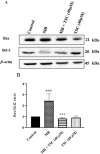
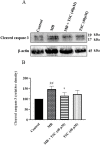
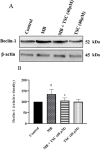
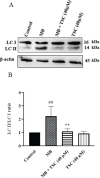
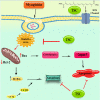
Similar articles
-
Trans-sodium crocetinate ameliorates Parkinson-like disease caused by bisphenol A through inhibition of apoptosis and reduction of α-synuclein in rats.Iran J Basic Med Sci. 2025;28(2):254-263. doi: 10.22038/ijbms.2024.81157.17567. Iran J Basic Med Sci. 2025. PMID: 39850110 Free PMC article.
-
Effect of trans-sodium crocetinate on contrast-induced cytotoxicity in HEK-293 cells.Iran J Basic Med Sci. 2023 Feb;26(2):148-156. doi: 10.22038/IJBMS.2022.64671.14234. Iran J Basic Med Sci. 2023. PMID: 36742140 Free PMC article.
-
Trans-sodium crocetinate attenuates acute kidney injury induced by rhabdomyolysis in rats: focusing on PI3K/AKT, apoptosis, and autophagy pathways.Naunyn Schmiedebergs Arch Pharmacol. 2025 Mar 13. doi: 10.1007/s00210-025-03910-9. Online ahead of print. Naunyn Schmiedebergs Arch Pharmacol. 2025. PMID: 40080154
-
Evaluation of pathways involved in the protective effect of trans sodium crocetinate against contrast-induced nephropathy in rats.Naunyn Schmiedebergs Arch Pharmacol. 2025 May;398(5):5373-5387. doi: 10.1007/s00210-024-03600-y. Epub 2024 Nov 16. Naunyn Schmiedebergs Arch Pharmacol. 2025. PMID: 39549062
-
Ulinastatin Alleviates Rhabdomyolysis-Induced Acute Kidney Injury by Suppressing Inflammation and Apoptosis via Inhibiting TLR4/NF-κB Signaling Pathway.Inflammation. 2022 Oct;45(5):2052-2065. doi: 10.1007/s10753-022-01675-4. Epub 2022 Jun 6. Inflammation. 2022. PMID: 35668155
Cited by
-
Herbal medicine approach to relieving dyspnea: A narrative review of efficacy and mechanisms.Iran J Basic Med Sci. 2025;28(9):1140-1162. doi: 10.22038/ijbms.2025.85518.18486. Iran J Basic Med Sci. 2025. PMID: 40809176 Free PMC article. Review.
-
Effect of Crocus sativus L. (saffron) and Rosmarinus officinalis L. (rosemary) in hepatocellular carcinoma: A narrative review of current evidence and prospects.Iran J Basic Med Sci. 2025;28(8):986-1003. doi: 10.22038/ijbms.2025.84172.18204. Iran J Basic Med Sci. 2025. PMID: 40584445 Free PMC article. Review.
-
Trans-sodium crocetinate ameliorates Parkinson-like disease caused by bisphenol A through inhibition of apoptosis and reduction of α-synuclein in rats.Iran J Basic Med Sci. 2025;28(2):254-263. doi: 10.22038/ijbms.2024.81157.17567. Iran J Basic Med Sci. 2025. PMID: 39850110 Free PMC article.
-
Assessing the efficacy of herbal supplements for managing obesity: A comprehensive review of global clinical trials.Iran J Basic Med Sci. 2025;28(6):691-709. doi: 10.22038/ijbms.2025.84150.18198. Iran J Basic Med Sci. 2025. PMID: 40343290 Free PMC article. Review.
References
-
- Zutt R, Van Der Kooi AJ, Linthorst GE, Wanders RJA, De Visser M. Rhabdomyolysis: review of the literature. Neuromuscul Disord. 2014;24:651–659. - PubMed
-
- Ui Kong D, Zhang Xu, Zhou J, Wang Y, Feng Z, Zhang X, et al. Myoglobin-induced apoptosis: two pathways related to endoplasmic reticulum stress. Ther Apher Dial. 2012;16:272–280. - PubMed
-
- Zager RA. Mitochondrial free radical production induces lipid peroxidation during myohemoglobinuria. Kidney Int. 1996;49:741–751. - PubMed
LinkOut - more resources
Full Text Sources
Research Materials
Miscellaneous
